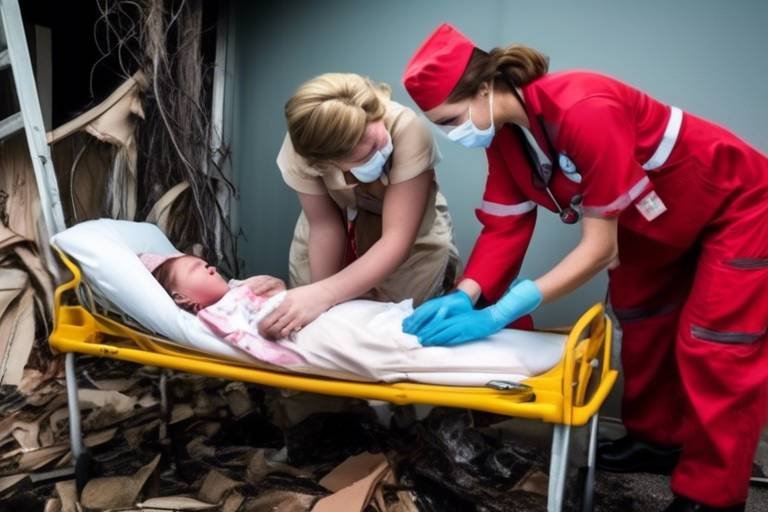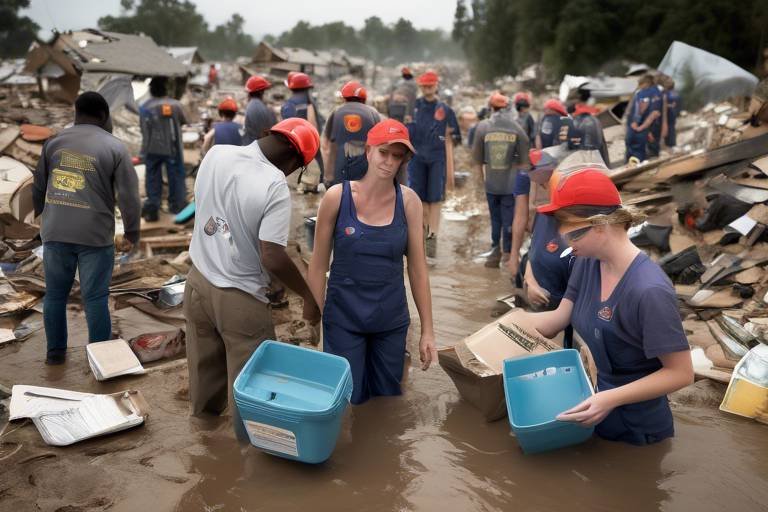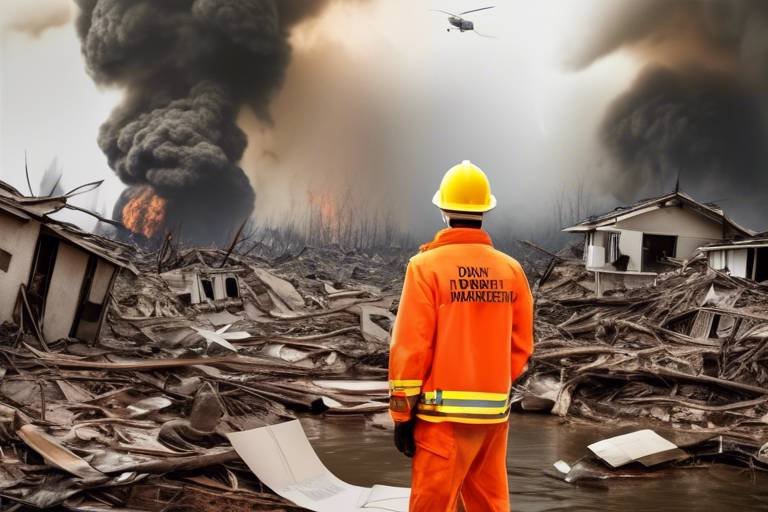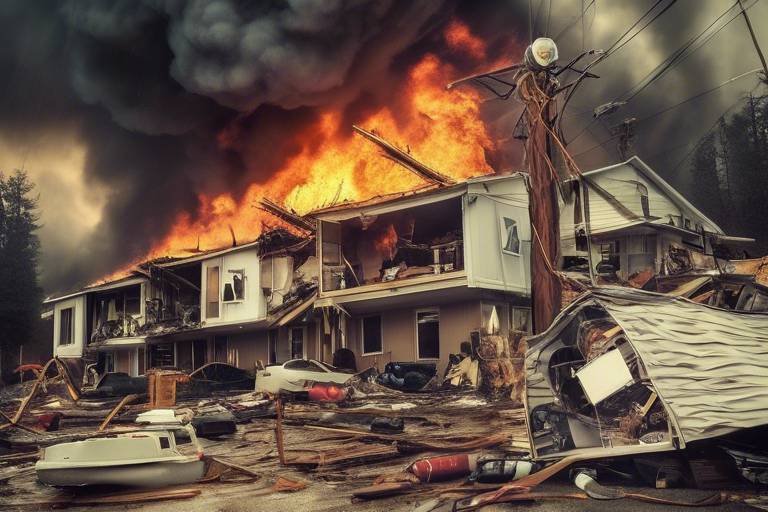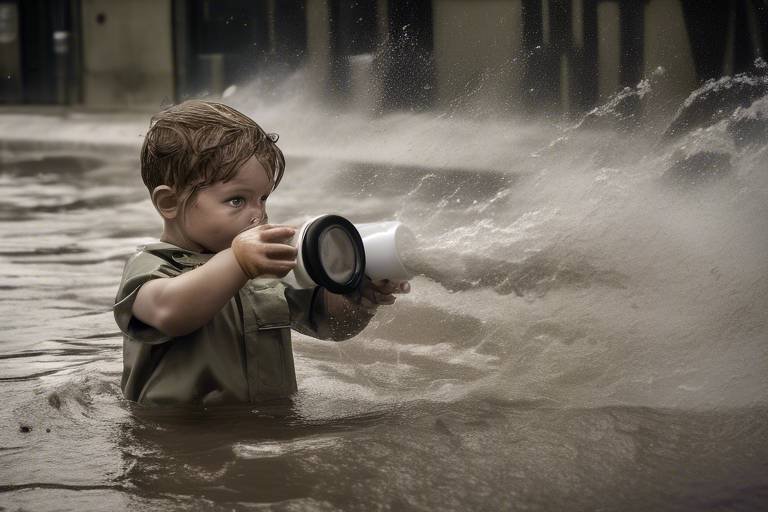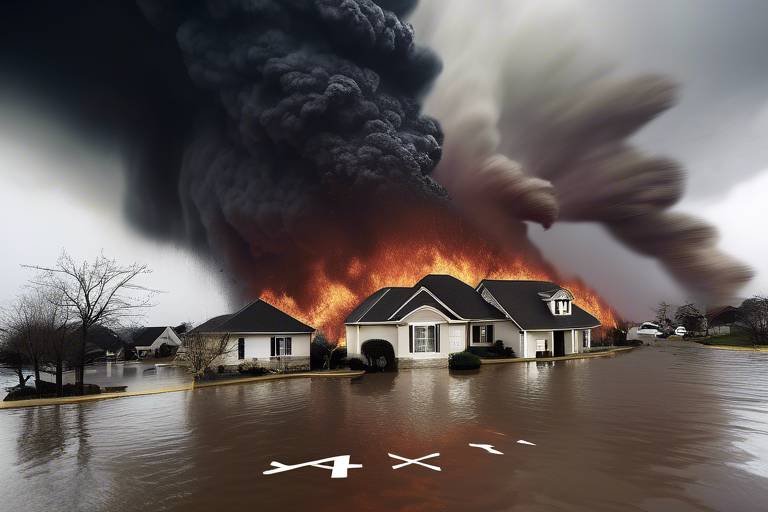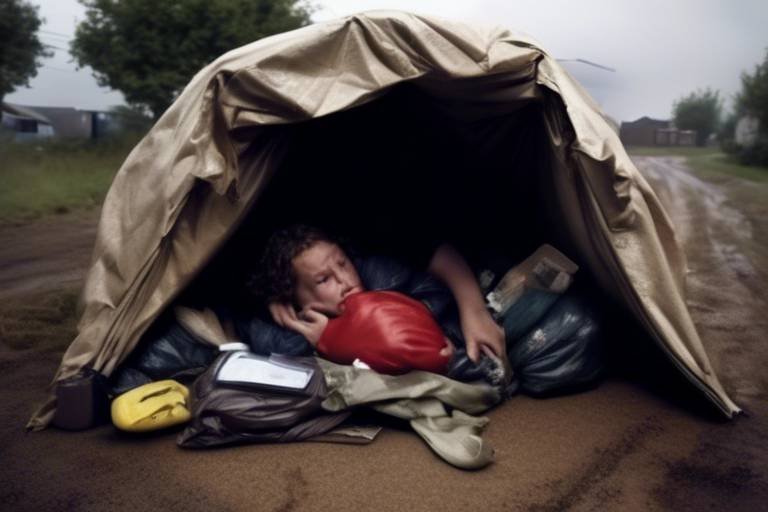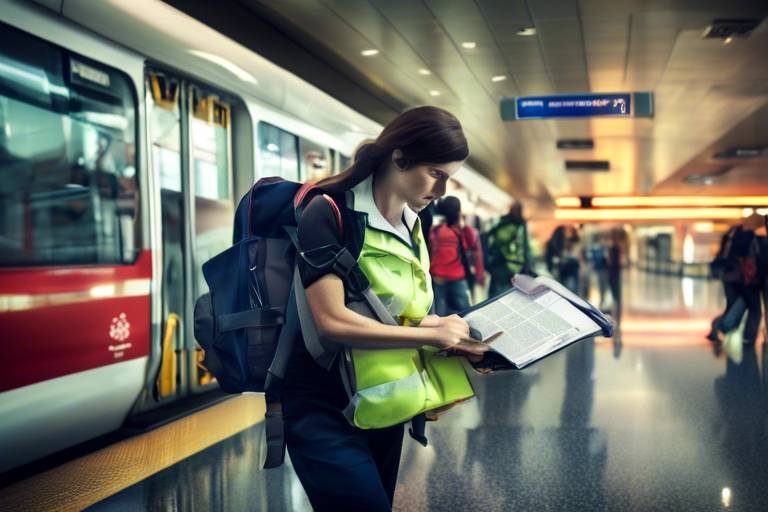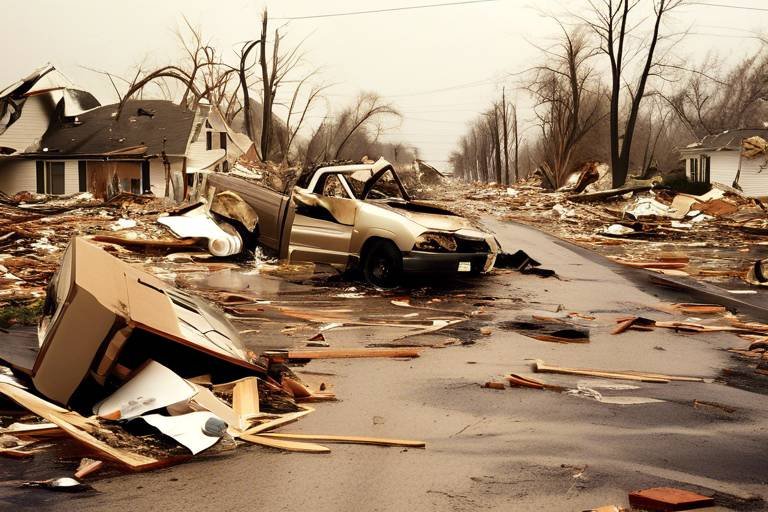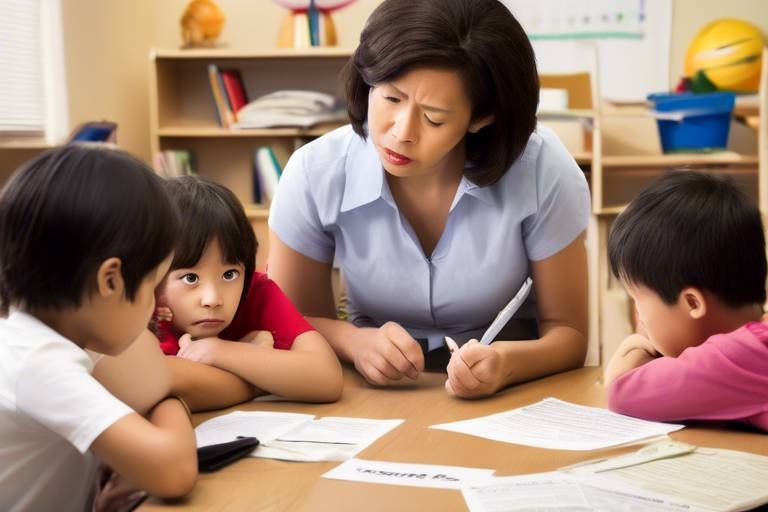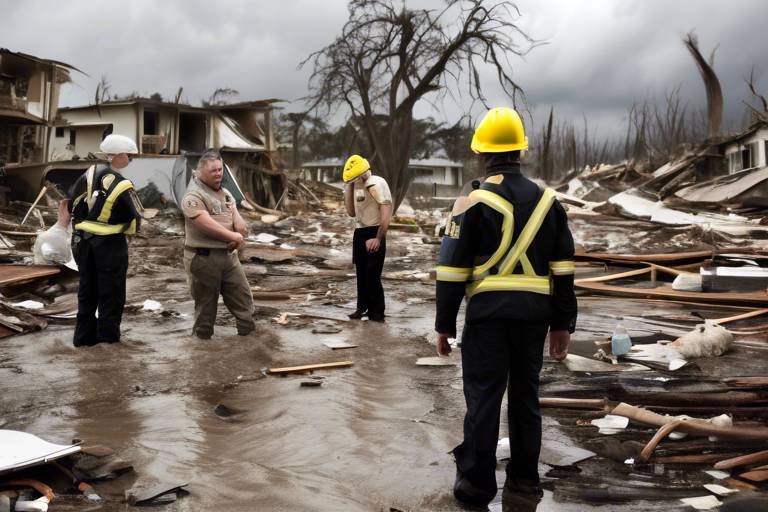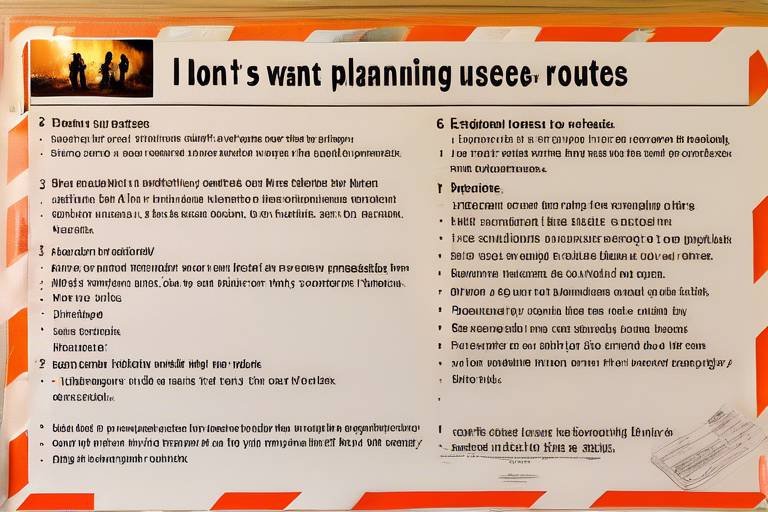Maintaining Physical and Mental Health During Disasters
Disasters can strike at any moment, turning our lives upside down in the blink of an eye. Whether it's a natural disaster like a hurricane or an unexpected crisis such as a pandemic, the effects can be overwhelming. The key to navigating these tumultuous times lies in maintaining both our physical and mental health. But how can we effectively prepare ourselves for such unforeseen events? This article dives into the strategies that not only emphasize preparedness but also highlight the importance of community support and self-care practices. By equipping ourselves with the right tools and mindset, we can emerge from these challenges stronger and more resilient.
First, let's take a moment to recognize the profound impacts disasters can have on our lives. Beyond the immediate physical dangers, disasters can lead to a surge of stress and anxiety. Imagine waking up to the sound of sirens, your heart racing as you realize that your life might change in an instant. This emotional turmoil can manifest in various ways, from panic attacks to long-term mental health issues like PTSD. Understanding these impacts is crucial for effective management and recovery. By acknowledging the emotional and physical tolls, we can better prepare ourselves to face the storm.
Preparation is not just a buzzword; it’s a lifeline during crises. Having a solid plan can make all the difference when chaos reigns. So, what steps should we take to ensure our safety and health? First and foremost, creating an emergency plan is essential. This plan should outline specific actions to take during a disaster, such as evacuation routes and designated meeting points for family members. Think of it as your personal roadmap to safety. Additionally, assembling a disaster kit filled with essential supplies—like food, water, and medications—ensures that you can sustain yourself in difficult situations. It’s like packing for a journey, but this time, the destination is safety.
An effective emergency plan is like a well-rehearsed script for an unexpected play. It outlines the steps to take during a disaster, ensuring safety and reducing panic. Your plan should include:
- Evacuation routes: Know where to go and how to get there.
- Communication strategies: Decide how you’ll stay in touch with loved ones.
- Designated meeting points: Choose safe spots where family members can regroup.
Having these elements in place not only enhances your safety but also provides peace of mind when facing uncertainty.
Imagine being caught in a storm without any supplies—it's a nightmare scenario. A well-stocked disaster kit can provide essential supplies during emergencies, ensuring you’re not left scrambling when the time comes. Your kit should contain:
- Non-perishable food items
- Water (at least one gallon per person per day for three days)
- Medications and first aid supplies
- Flashlights and batteries
- Important documents (insurance, IDs, etc.)
By preparing ahead of time, you create a safety net that can sustain you through the worst of times.
During a disaster, keeping in touch with family and friends is vital. Establishing reliable communication channels ensures that loved ones can check in on each other and share important updates. Consider using multiple methods—like group chats, social media, or dedicated emergency apps—to stay connected. It’s like having a safety line that not only reassures you but also keeps you informed.
We often hear that it takes a village, and this is especially true during disasters. Community support plays a crucial role in disaster resilience. By fostering connections with your neighbors and collaborating with local organizations, you can create a strong support network. This network can provide not just emotional support but also practical help, such as sharing resources or information during a crisis. Think of your community as your safety net—together, you can weather any storm.
Amidst the chaos, don't forget about self-care. It’s essential for maintaining mental health during disasters. Techniques such as mindfulness, exercise, and healthy eating can promote emotional well-being even in challenging times. Just like you wouldn’t neglect a car in a storm, you shouldn’t neglect your own needs.
Practicing mindfulness can be a game-changer during disasters. Techniques like meditation and deep breathing can ground you, allowing you to navigate your emotions more effectively. When everything feels out of control, taking a moment to breathe deeply can help restore a sense of calm. It’s like hitting the reset button on your mind.
Regular physical activity is vital for both physical and mental health. Engaging in exercise can boost mood, reduce stress, and enhance overall well-being, even during times of crisis. Whether it’s a quick home workout or a brisk walk around the neighborhood, staying active is a powerful tool in your self-care arsenal.
Finally, accessing mental health resources is crucial during and after disasters. There are numerous services available, including counseling and hotlines, that can support individuals facing emotional challenges. Don’t hesitate to reach out for help; it’s a sign of strength, not weakness. Remember, you are not alone in this journey.
Q: How can I prepare my children for a disaster?
A: Involve them in creating an emergency plan and disaster kit. Teach them about safety measures in a way that feels engaging and not frightening.
Q: What should I do if I feel overwhelmed during a disaster?
A: It's completely normal to feel overwhelmed. Practice mindfulness techniques, reach out to friends or family, and consider contacting a mental health professional.
Q: How can I support my neighbors during a disaster?
A: Check in on them, share resources, and offer help with tasks like grocery shopping or providing transportation to shelters.

Understanding the Impact of Disasters
Disasters, whether natural or man-made, can have **profound** and **lasting effects** on both our physical and mental health. When a disaster strikes, it often leads to a whirlwind of emotions, including **stress**, **anxiety**, and even **fear**. Imagine waking up to the sound of sirens blaring, or the ground shaking beneath your feet; it’s enough to send anyone into a panic. Understanding these impacts is crucial for effective management and recovery.
Physically, disasters can result in injuries, loss of shelter, and disruption of essential services. For instance, after a hurricane or earthquake, access to clean water and food may become scarce, leading to health complications. Additionally, the physical toll of evacuation and displacement can exacerbate pre-existing health issues. The table below illustrates some common physical health impacts associated with various types of disasters:
| Type of Disaster | Common Physical Impacts |
|---|---|
| Earthquake | Injuries from falling debris, fractures, and trauma |
| Flood | Waterborne diseases, respiratory issues from mold |
| Hurricane | Injuries from flying objects, heat exhaustion |
| Wildfire | Smoke inhalation, burns, respiratory issues |
On the mental health front, the aftermath of a disaster can be equally devastating. Many individuals experience **post-traumatic stress disorder (PTSD)**, depression, and anxiety. The uncertainty and disruption of daily life can lead to feelings of helplessness and isolation. It's not uncommon for people to feel overwhelmed by the loss of their homes, livelihoods, or even loved ones. In fact, studies have shown that survivors of disasters often report a significant increase in psychological distress. Here are some common mental health impacts:
- Increased Anxiety: Constant worry about safety and the future can become overwhelming.
- Depression: Feelings of sadness and hopelessness can linger long after the disaster.
- Social Withdrawal: Many individuals may isolate themselves, avoiding social interactions.
Recognizing these impacts is the first step towards effective management and recovery. By understanding that both physical and mental health can be compromised during disasters, individuals and communities can better prepare themselves to face these challenges. It’s essential to foster resilience and support networks to navigate through the chaos that disasters bring. After all, we are all in this together, and having a solid support system can make a world of difference in overcoming the adversities that come our way.

Preparing for Disasters
When it comes to disasters, preparation is not just a good idea; it's essential! Imagine you're caught in a storm, and the power goes out. What do you do? Panic? Or do you reach for your well-prepared emergency kit? Being prepared means you can face crises with confidence instead of fear. To maintain your health during such challenging times, you need to take proactive steps that encompass both physical supplies and mental readiness. Let's dive into the crucial components of disaster preparation.
First and foremost, creating an effective emergency plan is a must. This plan serves as your roadmap during a disaster, guiding you on what to do and where to go. It should include essential details like evacuation routes, communication strategies, and designated meeting points for your family. Think of it as your safety net—a well-laid-out guide that can significantly reduce panic when chaos strikes. If everyone in your household knows the plan, you can navigate through emergencies more smoothly.
When crafting an emergency plan, involve every member of your family. Make it a fun activity! Discuss various scenarios together and decide on the best actions to take. For instance, if you need to evacuate, where will you go? How will you communicate if cell networks are down? Establishing these details in advance can make a world of difference. Don't forget to write everything down and keep copies in easily accessible places, like your fridge or wallet.
Next, let’s talk about assembling a disaster kit. This kit is your lifeline during emergencies, and it should be stocked with essential supplies to last at least 72 hours. Think of it like a mini survival kit. What should it include? Here’s a quick rundown:
- Water: At least one gallon per person per day.
- Food: Non-perishable items like canned goods, energy bars, and dried fruits.
- Medications: A supply of any prescription drugs you may need.
- First Aid Kit: Band-aids, antiseptics, and other medical supplies.
- Tools: A multi-tool, flashlight, and batteries.
Make sure to check your kit regularly and replace items that expire. Having a well-stocked kit can provide peace of mind and ensure you have what you need when the unexpected happens.
Another critical aspect of disaster preparation is establishing communication channels. In times of crisis, staying connected with family and friends can be a source of strength. Consider designating an out-of-town contact who can help relay information. This way, if local communication fails, you still have a lifeline. Also, keep a list of important phone numbers, including local emergency services, handy. You never know when you might need them!
In conclusion, preparing for disasters is about more than just gathering supplies; it's about creating a comprehensive strategy that encompasses planning, communication, and community. By taking these steps, you not only enhance your resilience but also empower yourself to navigate through challenging times with greater ease.
Q: How often should I update my emergency plan?
A: It's advisable to review and update your emergency plan at least once a year or whenever there are significant changes in your family or living situation.
Q: What should I do if I can't find certain items for my disaster kit?
A: If you can't find specific items, focus on alternatives that can serve the same purpose. For example, if you can't find a flashlight, consider using candles or battery-powered lanterns.
Q: How can I involve my children in disaster preparedness?
A: Engage your children by turning preparedness into a fun activity. Have them help pack the disaster kit or practice your emergency plan together. This will not only educate them but also reduce their anxiety during actual emergencies.

Creating an Emergency Plan
This article explores strategies to sustain both physical and mental well-being during disasters, emphasizing the importance of preparedness, community support, and self-care practices to navigate challenging times effectively.
Disasters can have profound effects on both physical and mental health, leading to stress, anxiety, and physical injuries. Recognizing these impacts is crucial for effective management and recovery.
Preparation is key to maintaining health during disasters. This section discusses essential planning steps, including emergency kits, communication plans, and mental readiness to enhance resilience in the face of crises.
Creating an effective emergency plan is like drawing a roadmap for safety during chaotic times. It outlines the steps to take when disaster strikes, ensuring that you and your loved ones know exactly what to do. Imagine being in the middle of a storm; having a plan can be your guiding light, reducing panic and confusion. Your emergency plan should cover several critical components:
- Evacuation Routes: Identify the safest and quickest paths to evacuate your home or area. Knowing multiple routes can be a lifesaver, especially if one is blocked.
- Communication Strategies: Establish how your family will communicate during a disaster. This could include designating a family member as a point of contact or using specific messaging apps.
- Meeting Points: Choose a safe location where your family can gather if separated. This could be a neighbor’s house or a local community center.
In addition to these components, consider the unique needs of your family. For instance, if you have young children or elderly relatives, ensure that your plan accounts for their specific requirements. It’s also wise to practice your emergency plan regularly; just like fire drills in school, rehearsing your plan can help everyone feel more confident and prepared.
Finally, document your emergency plan clearly. Write it down, print it out, and keep copies in accessible locations. You might even want to create a digital version that can be shared with friends and family. Remember, the goal is to minimize chaos and maximize safety during a disaster.
A well-stocked disaster kit can provide essential supplies during emergencies. It should contain food, water, medications, and first aid items, ensuring that individuals can sustain themselves in difficult situations.
Maintaining communication with family and friends during a disaster is vital. Establishing reliable channels ensures that loved ones can check in on each other and share important updates.
Community support plays a crucial role in disaster resilience. This section highlights the importance of fostering connections and collaborating with neighbors to create a strong support network during emergencies.
Self-care is essential for maintaining mental health during disasters. This section explores techniques such as mindfulness, exercise, and healthy eating to promote emotional well-being in challenging times.
Practicing mindfulness can help reduce stress and anxiety during disasters. Techniques like meditation and deep breathing can ground individuals, allowing them to navigate their emotions more effectively.
Regular physical activity is vital for both physical and mental health. Engaging in exercise can boost mood, reduce stress, and enhance overall well-being, even during times of crisis.
Accessing mental health resources is crucial during and after disasters. This section discusses available services, including counseling and hotlines, to support individuals facing emotional challenges in the aftermath of crises.
Q: What should I include in my emergency kit?
A: Your emergency kit should include essentials like water, non-perishable food, medications, a flashlight, batteries, a first-aid kit, and important documents.
Q: How often should I review my emergency plan?
A: It’s advisable to review your emergency plan at least once a year, or whenever there are changes in your family or living situation.
Q: How can I support my mental health during a disaster?
A: Engage in self-care practices such as mindfulness, staying active, and maintaining social connections with friends and family to support your mental health.
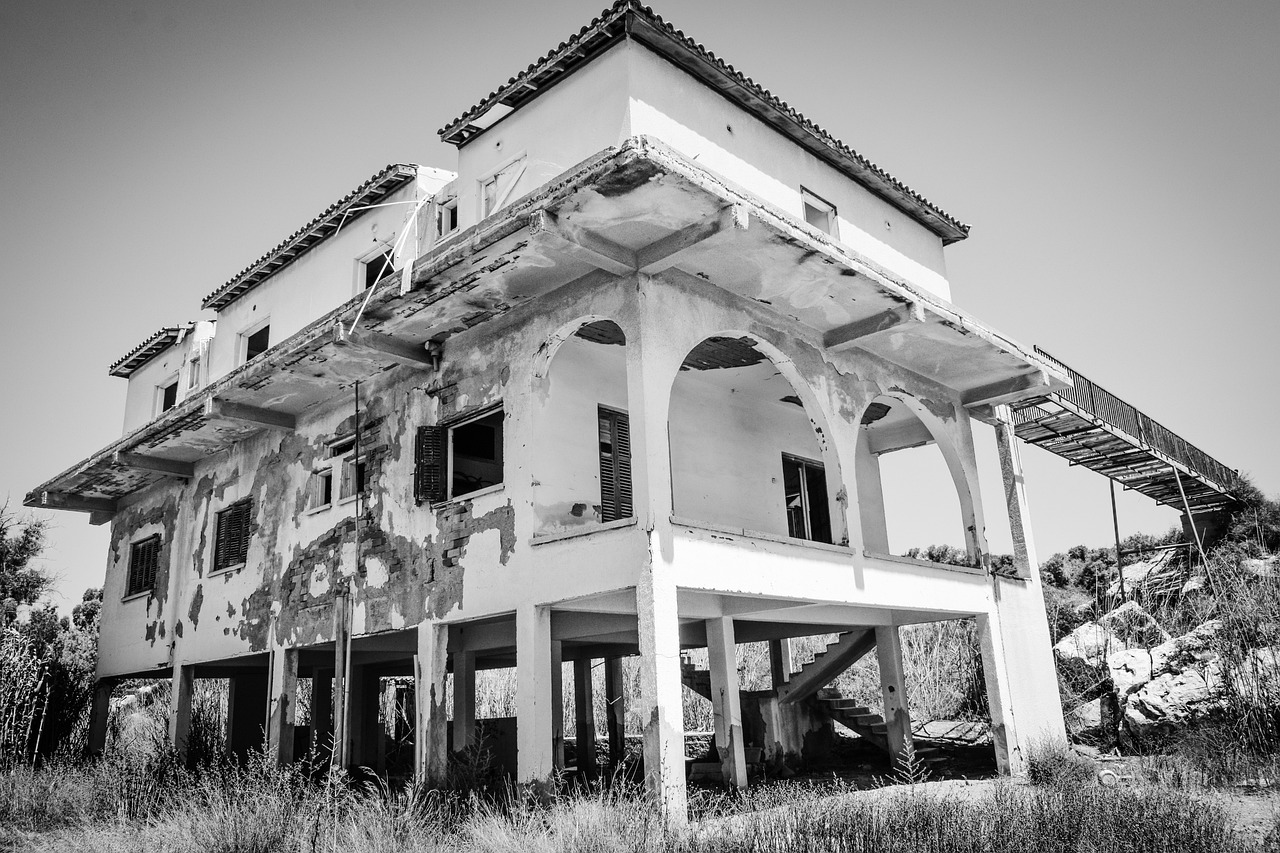
Assembling a Disaster Kit
When disaster strikes, having a well-prepared disaster kit can mean the difference between chaos and calm. Imagine being caught in a storm or an unexpected emergency, and you find yourself scrambling for essentials. It’s like trying to find your way in the dark without a flashlight. A disaster kit acts as your guiding light, ensuring you have everything you need to stay safe and healthy during challenging times. So, what should you pack in this all-important kit? Let’s break it down.
First and foremost, the foundation of any disaster kit is food and water. You should aim to have at least a three-day supply of non-perishable food items. Think about canned goods, dried fruits, and energy bars. These items not only provide necessary nutrition but are also easy to store. As for water, the general recommendation is to have one gallon per person per day. So, if you have a family of four, that’s a minimum of 12 gallons to ensure everyone stays hydrated.
Next up, let’s talk about medications and first aid supplies. It’s crucial to include any prescription medications, as well as a basic first aid kit. This kit should contain items like band-aids, antiseptic wipes, and pain relievers. You can think of it as your personal health toolbox, ready to tackle minor injuries or ailments that may arise during a disaster.
Additionally, don’t forget about important documents. Having copies of your identification, insurance policies, and medical records can save you a lot of headaches down the line. Consider keeping these documents in a waterproof bag to protect them from the elements. It’s like having a safety net; you may not need it, but it’s comforting to know it’s there.
Another critical component is a multi-tool or Swiss Army knife. This handy gadget can assist in various situations, from opening cans to making minor repairs. It’s the ultimate survival companion, compact yet incredibly versatile.
Finally, consider including items that can help you stay informed and connected. A battery-powered or hand-crank radio can keep you updated on emergency broadcasts, while extra batteries and a power bank for your phone ensure you can communicate with loved ones. In times of crisis, staying connected is vital, and having these tools at your disposal is like having a lifeline.
To sum it all up, here’s a quick overview of what to include in your disaster kit:
| Item | Quantity |
|---|---|
| Non-perishable food | 3-day supply |
| Water | 1 gallon per person per day |
| Prescription medications | As needed |
| First aid kit | 1 kit |
| Important documents | As needed |
| Multi-tool | 1 |
| Battery-powered radio | 1 |
| Power bank | 1 |
By assembling a comprehensive disaster kit, you’re not just preparing for the worst; you’re empowering yourself and your loved ones to face any challenge head-on. Remember, the key to resilience is preparation, and with the right tools at your fingertips, you can navigate through the storm with confidence.
- How often should I check my disaster kit? It's a good idea to review your kit every six months to ensure that food and medications are not expired and to update any necessary items.
- What should I do with my disaster kit if I have to evacuate? If you need to evacuate, take your disaster kit with you. It’s designed to support you in emergencies, whether at home or on the go.
- Can I customize my disaster kit? Absolutely! Tailor your kit to meet the specific needs of your household, including dietary restrictions or special medical needs.
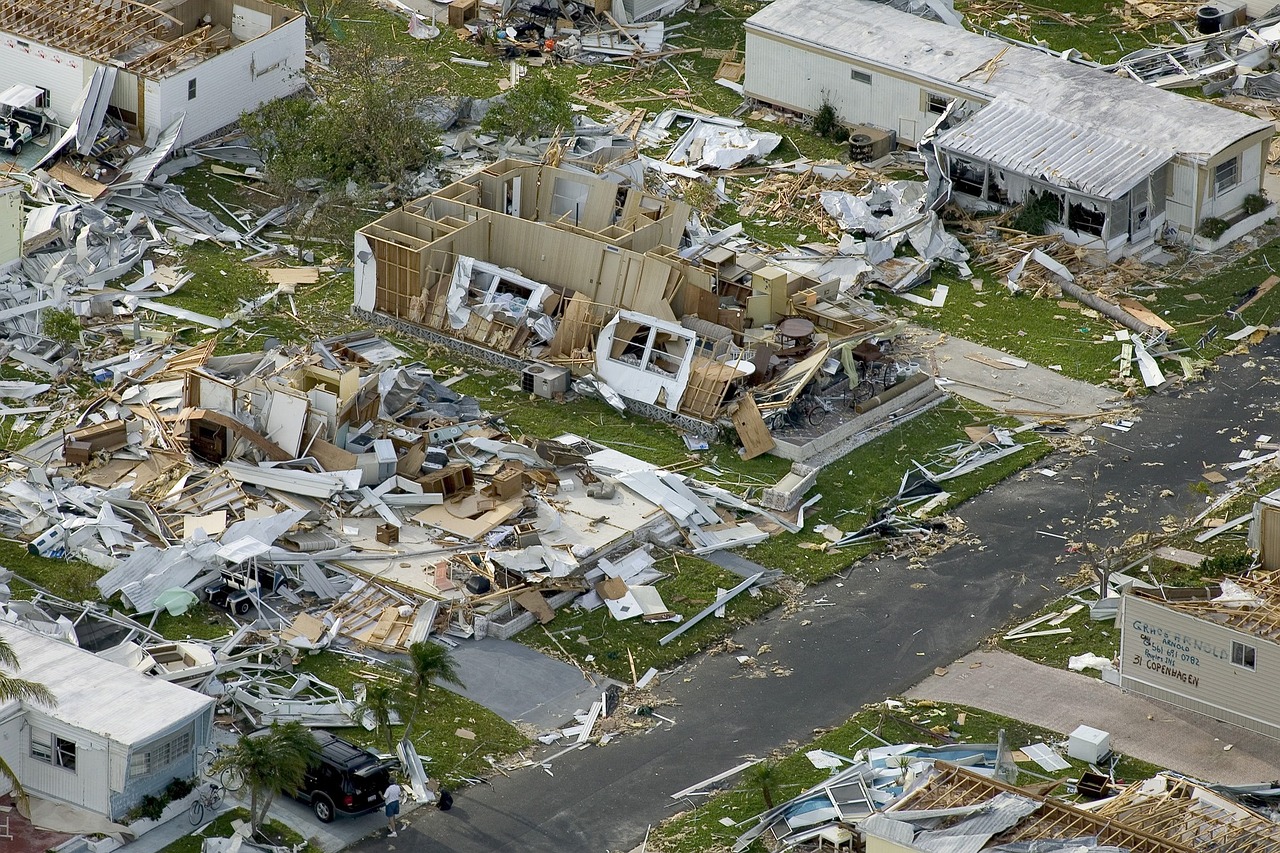
Establishing Communication Channels
During a disaster, one of the most vital components of safety and reassurance is maintaining clear and reliable communication channels. Think of it as your lifeline; when chaos reigns, knowing how to reach out to loved ones can significantly ease anxiety and foster a sense of community. Establishing these channels before a disaster strikes can save precious time and reduce panic. It’s like setting up a safety net that can catch you when you fall.
First and foremost, it’s essential to have a communication plan in place. This plan should outline how you and your family will stay in touch during an emergency. For instance, consider designating a family communication leader who will be responsible for keeping everyone informed. This person can coordinate messages and updates, ensuring that everyone is on the same page. It’s also wise to choose a safe meeting point, a location where everyone knows to gather if phone lines fail. This could be a neighbor’s house, a local park, or any place that’s easily accessible.
In addition to creating a plan, utilizing technology can bolster your communication efforts. Apps like WhatsApp or Signal allow for group messaging, which can be incredibly useful for sharing updates quickly. Moreover, consider using social media platforms to post information about your well-being or to check in with others. However, be cautious about misinformation; always verify the sources of any updates you receive.
In case of power outages or network failures, having a backup plan is crucial. Here are a few suggestions to ensure you can still communicate:
- Text over Calls: Text messages often go through even when calls fail due to network congestion. Encourage your family to send texts instead of calling.
- Two-Way Radios: Investing in walkie-talkies or two-way radios can be a lifesaver, especially in areas where cell service is unreliable.
- Emergency Contact List: Keep a printed list of emergency contacts, including family members, friends, and local emergency services. Distribute copies to all family members.
Lastly, don’t underestimate the power of community support. Establishing communication channels with neighbors can create a robust support network. Consider organizing neighborhood meetings to discuss emergency plans and share contact information. This collective approach not only helps in emergencies but also strengthens community bonds.
By taking these proactive steps to establish communication channels, you can significantly enhance your safety and peace of mind during a disaster. Remember, it’s all about being prepared and staying connected, even when the world around you feels chaotic.
Q: What should I include in my emergency communication plan?
A: Your emergency communication plan should include designated contacts, a safe meeting point, and alternative communication methods like texts or two-way radios.
Q: How can I ensure my family stays connected during a power outage?
A: Consider using text messaging, two-way radios, and keeping a printed list of emergency contacts to ensure communication during a power outage.
Q: What role does community play in disaster communication?
A: Community connections can provide additional support and resources during a disaster. Collaborating with neighbors to share plans and contact information can enhance safety for everyone.

Building Community Support
When disaster strikes, the strength of a community can make all the difference. Think of it like a sturdy bridge; each person is a vital part of that structure, working together to support one another during tough times. Building community support involves more than just knowing your neighbors; it’s about creating a network where everyone feels safe, connected, and empowered to help each other. By fostering relationships and collaborating with those around us, we can significantly enhance our collective resilience.
One of the first steps in building this support is to establish open lines of communication. Regular neighborhood meetings can serve as a platform for residents to share their concerns, exchange resources, and develop a collective emergency response plan. Imagine a neighborhood where everyone knows who to call for help, or where families have a designated meeting point in case of an emergency. This proactive approach not only alleviates panic but also strengthens bonds among community members.
Additionally, organizing community events can help break down barriers and foster connections. Whether it's a potluck dinner, a clean-up day, or a preparedness workshop, these gatherings create opportunities for individuals to come together, share their stories, and learn from one another. When people feel valued and included, they are more likely to reach out during a crisis. A simple “how can I help?” can go a long way in building trust and solidarity.
It's also essential to identify and utilize local resources. Communities often have access to various support services, from mental health resources to food banks. By mapping out these resources and sharing the information widely, residents can ensure that everyone knows where to turn for assistance. Consider creating a community resource guide that includes contact information for local shelters, counseling services, and volunteer organizations. This guide can be distributed digitally or in print, making it accessible to all.
Moreover, engaging local leaders and organizations can amplify your community support efforts. Schools, churches, and local businesses can play pivotal roles in disaster preparedness and recovery. By partnering with these entities, communities can coordinate larger initiatives, such as disaster drills or fundraising events for relief efforts. Remember, the more diverse the support network, the stronger the community will be in facing challenges.
In summary, building community support is a dynamic and ongoing process. It requires effort, communication, and a shared commitment to looking out for one another. When we come together, we not only enhance our ability to cope with disasters but also enrich our everyday lives, creating a vibrant, supportive environment for all. So, take that first step today—reach out to a neighbor, attend a local event, or start a conversation about preparedness. Together, we can create a resilient community that stands strong against any storm.
- How can I get involved in my community's disaster preparedness efforts? Start by attending local meetings or volunteering with organizations focused on emergency response.
- What should I include in a community resource guide? Include contact information for local shelters, food banks, mental health services, and emergency contacts.
- How can I support my neighbors during a disaster? Offer to check in on them, share resources, and help with any immediate needs they may have.
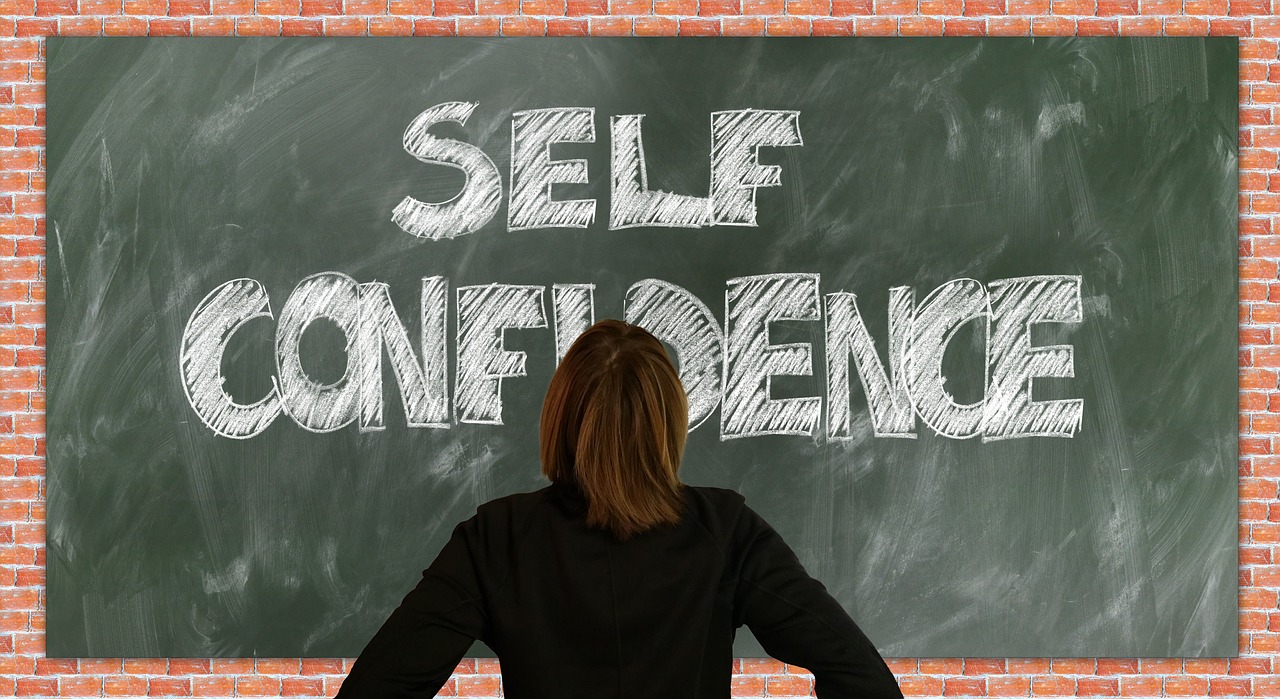
Practicing Self-Care During Crises
When disaster strikes, it's easy to feel overwhelmed, and often, our own well-being takes a back seat. But let me tell you, self-care is not a luxury; it’s a necessity during these challenging times. Just like you wouldn’t let your car run on empty, you shouldn’t neglect your mental and physical health either. Practicing self-care can be your lifeline, helping you navigate the storm with resilience and strength.
So, what does self-care look like during a crisis? It can be as simple as taking a moment to breathe deeply or as structured as setting aside time for physical activity. Here are some effective self-care strategies to consider:
- Mindfulness and Stress Reduction: Engaging in mindfulness practices can significantly reduce stress and anxiety. Techniques such as meditation, yoga, or even a few minutes of deep breathing can ground you. Imagine standing on a beach, feeling the waves wash over your feet; that’s the kind of peace you can cultivate through mindfulness.
- Staying Physically Active: Physical activity is a powerful antidote to stress. Whether it’s a brisk walk around your neighborhood or an online workout session, moving your body releases endorphins, those feel-good hormones. Think of exercise as a natural mood booster that’s always available, even when the world feels chaotic.
- Healthy Eating: Nourishing your body with healthy foods can have a positive impact on your mood and energy levels. It’s tempting to reach for comfort food during tough times, but incorporating fruits, vegetables, and whole grains can help keep your mind clear and your energy steady.
Moreover, don’t underestimate the power of social connections. While physical distancing might be necessary during some disasters, emotional closeness is vital. Reach out to friends and family, share your feelings, and listen to theirs. Just like a sturdy bridge supports traffic, your relationships can provide support and stability during turbulent times.
In addition to these practices, it’s essential to recognize when you need professional help. Sometimes, the weight of a disaster can feel too heavy to bear alone. Accessing mental health resources, whether through hotlines or local counseling services, is a crucial step toward healing. Remember, seeking help is a sign of strength, not weakness.
In summary, practicing self-care during crises is about nurturing your mind and body. It’s about recognizing your needs and taking proactive steps to meet them. By incorporating mindfulness, physical activity, healthy eating, and social support into your routine, you can maintain your well-being even in the face of adversity.
Q: What are some quick self-care tips during a disaster?
A: Quick self-care tips include taking deep breaths, staying hydrated, reaching out to loved ones, and engaging in a short physical activity like stretching or walking.
Q: How can I practice mindfulness during a crisis?
A: You can practice mindfulness by dedicating a few minutes each day to meditation, focusing on your breath, or simply being present in the moment. Apps like Headspace or Calm can be helpful guides.
Q: What should I include in my emergency self-care kit?
A: Your emergency self-care kit should include items like water, non-perishable snacks, first aid supplies, any necessary medications, and a journal or coloring materials for stress relief.
Q: When should I seek professional help?
A: If you find that feelings of anxiety, depression, or stress are overwhelming and affecting your daily life, it’s important to seek professional help. Talking to a mental health professional can provide you with the support you need.

Mindfulness and Stress Reduction
In the whirlwind of a disaster, it's easy to feel overwhelmed, like you're caught in a storm with no way out. But here's the good news: mindfulness can be your anchor. This practice allows you to focus on the present moment, helping to reduce stress and anxiety that often accompany chaotic situations. Imagine standing in the eye of a hurricane, where everything is calm, while the chaos swirls around you. That's the power of mindfulness.
Mindfulness isn't just a trendy buzzword; it's a practical tool you can use to navigate through the emotional turbulence that disasters bring. By engaging in mindfulness techniques such as meditation, deep breathing, and even simple awareness exercises, you can create a mental space that fosters calmness and clarity. For instance, taking a few moments to sit quietly and focus on your breath can ground you, allowing you to regain control when everything feels out of hand.
To get started with mindfulness, consider these techniques:
- Deep Breathing: Inhale deeply through your nose, hold for a few seconds, and exhale slowly through your mouth. Repeat this several times to help alleviate tension.
- Body Scan: Close your eyes and mentally scan your body from head to toe, noticing areas of tension and consciously relaxing them.
- Guided Meditation: Use apps or online resources to find guided meditations specifically designed for stress relief.
Incorporating mindfulness into your daily routine can also help you build resilience over time. Just like a muscle, the more you practice, the stronger you become. Consider setting aside a few minutes each day for mindfulness exercises. Whether it’s in the morning to set a positive tone for the day or in the evening to unwind, these moments can make a significant difference in how you handle stress during crises.
Moreover, mindfulness can enhance your awareness of your thoughts and feelings, allowing you to respond to stressors more effectively rather than reacting impulsively. This is crucial during disasters when every decision counts. Think of it as having a mental toolkit that equips you to handle whatever comes your way. By practicing mindfulness, you not only improve your own mental health but also become a pillar of support for those around you, as a calm demeanor can be contagious in stressful situations.
Ultimately, embracing mindfulness is about finding peace amid chaos. It’s about recognizing that while you may not have control over external circumstances, you can control your internal responses. So, take a deep breath, ground yourself, and remember that even in the darkest times, there is a light within you that can shine through.
Q: What is mindfulness?
A: Mindfulness is the practice of being fully present in the moment, aware of your thoughts and feelings without judgment. It helps you manage stress and anxiety effectively.
Q: How can mindfulness help during a disaster?
A: By practicing mindfulness, you can reduce stress, improve emotional regulation, and enhance your ability to make clear decisions during chaotic situations.
Q: Do I need special training to practice mindfulness?
A: No special training is required! You can start with simple techniques like deep breathing or guided meditations available online.
Q: How often should I practice mindfulness?
A: Ideally, aim for at least a few minutes every day. Consistent practice can help build resilience and improve your mental health over time.

Staying Physically Active
Staying physically active during disasters might seem like a daunting task, especially when you're surrounded by chaos and uncertainty. However, engaging in regular exercise can be a game changer for both your body and mind. Think of it as a shield that protects you from the storm of stress and anxiety that often accompanies difficult times. When you keep moving, you’re not just burning calories; you’re also releasing endorphins, those magical little chemicals that lift your mood and help you feel more resilient.
Even during a disaster, there are ways to incorporate physical activity into your day. You don’t need a gym or fancy equipment; your body and the environment around you can serve as your workout tools. For instance, you could go for brisk walks in your neighborhood, practice yoga in your living room, or even do bodyweight exercises like push-ups and squats. The key is to find something you enjoy, as this will make it easier to stick with it. So, how about turning on some music and dancing around your living room? It’s a great way to lift your spirits!
If you’re wondering how to stay active when resources are limited, consider these simple ideas:
- Walking: This is one of the easiest and most effective ways to keep moving. Aim for at least 30 minutes a day, whether it's around your home or in a safe outdoor area.
- Bodyweight Exercises: Push-ups, squats, and lunges can be done anywhere. They require no equipment and can be modified to fit your fitness level.
- Stretching: Incorporating stretching into your routine can help relieve tension and keep your muscles flexible, especially if you're feeling stressed.
Moreover, staying active doesn’t have to be a solitary endeavor. Involve your family or neighbors! Organize group activities like outdoor games or walking clubs. This not only keeps you moving but also strengthens community bonds, which is crucial during tough times. Remember, the more you engage with others, the more support you’ll have, and the less isolated you’ll feel.
In the end, maintaining physical activity during disasters is about finding what works for you and sticking to it. It’s about creating a routine that provides not just physical benefits but also mental clarity and emotional stability. So, the next time you feel overwhelmed, just remember: a little movement can go a long way in keeping your spirits high and your mind clear.
Q: How much exercise should I aim for during a disaster?
A: Aim for at least 30 minutes of moderate activity most days of the week. This can be broken down into shorter sessions if needed.
Q: What if I don't have access to a gym or equipment?
A: No problem! You can do plenty of bodyweight exercises at home, such as push-ups, squats, and planks. Walking or jogging in place is also effective.
Q: How can I stay motivated to exercise during stressful times?
A: Set small, achievable goals and mix up your routine to keep things interesting. Involving friends or family can also help keep you accountable and motivated.
Q: Are there any specific exercises that can help reduce stress?
A: Yes! Activities like yoga and tai chi are excellent for reducing stress and improving mental clarity. Even simple deep-breathing exercises can be beneficial.
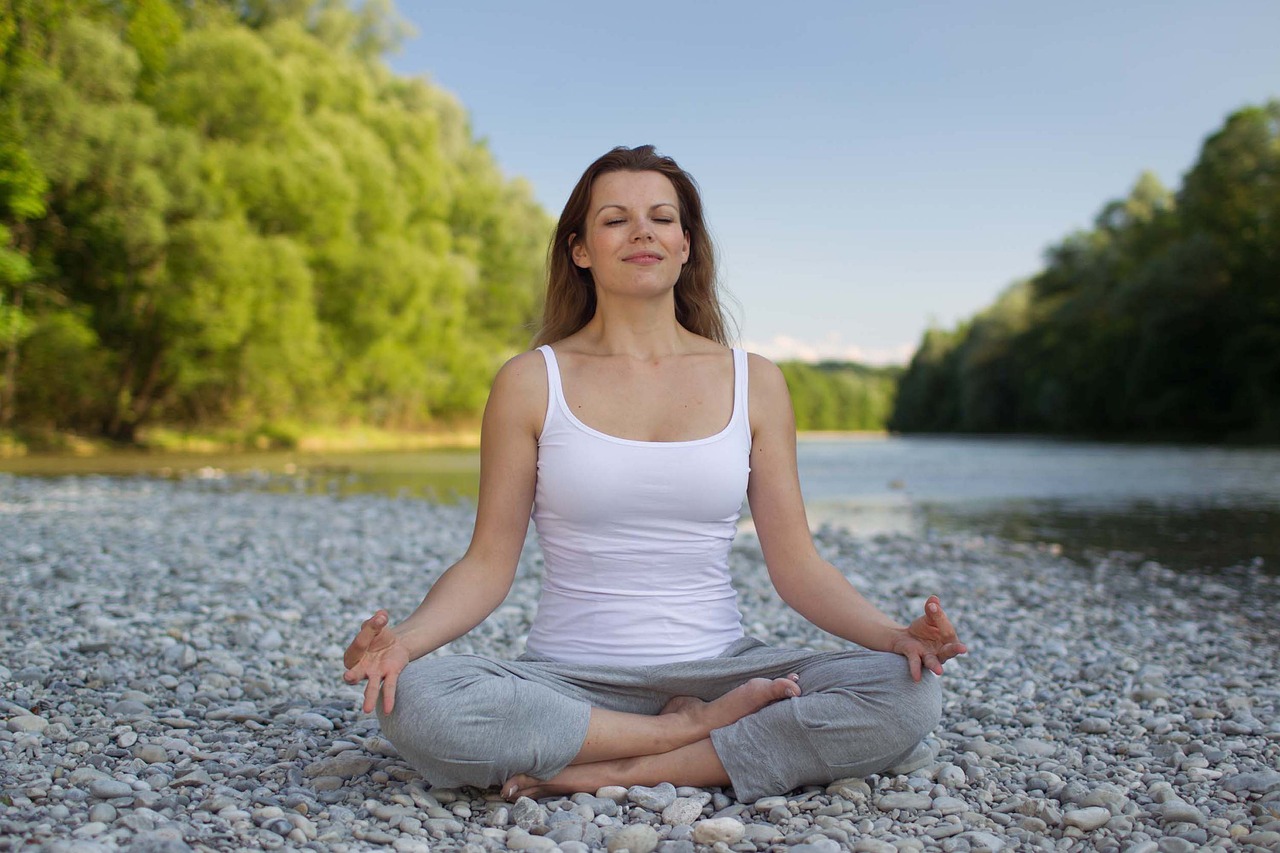
Accessing Mental Health Resources
In the wake of disasters, accessing mental health resources becomes not just important, but essential for recovery and resilience. When the world feels chaotic and overwhelming, having the right support can make all the difference. Many individuals may experience a range of emotions, from fear and anxiety to sadness and confusion. It’s crucial to know that you are not alone in these feelings, and there are resources available to help you navigate this challenging time.
One of the first steps in accessing mental health support is to identify the resources available in your community. Many organizations and agencies offer services specifically designed to assist individuals impacted by disasters. These can include counseling services, support groups, and hotlines that provide immediate assistance. Knowing where to turn can alleviate some of the stress associated with seeking help.
You might wonder, "What types of mental health resources are out there?" Here’s a brief overview:
- Crisis Hotlines: These are available 24/7 and can provide immediate support and guidance. You can talk to trained professionals who can help you through your feelings and offer coping strategies.
- Counseling Services: Many communities have mental health clinics that offer therapy sessions. These can be invaluable for processing emotions and developing healthy coping mechanisms.
- Support Groups: Connecting with others who have had similar experiences can be incredibly healing. Support groups provide a safe space to share feelings and experiences, fostering a sense of community.
Additionally, many local and national organizations have stepped up to provide resources during disasters. For instance, the National Alliance on Mental Illness (NAMI) and the American Red Cross offer various programs and services tailored to mental health support in crisis situations. These organizations often have websites where you can find information about available resources and how to access them.
It's also essential to consider digital resources. In today’s tech-savvy world, many mental health services are available online. Teletherapy has gained popularity, allowing individuals to connect with mental health professionals from the comfort of their homes. This can be especially beneficial during a disaster when traveling may not be safe or feasible. Platforms like BetterHelp and Talkspace provide access to licensed therapists through video calls, messaging, and phone calls, making it easier than ever to seek help.
Finally, don’t underestimate the power of self-help resources. Books, podcasts, and online courses focused on mental health can provide valuable insights and coping strategies. Engaging with these materials can empower you to take control of your mental well-being.
As we navigate through the aftermath of a disaster, remember that seeking help is a sign of strength. Whether it’s reaching out to a friend, contacting a professional, or participating in a support group, taking that first step can lead to healing and recovery. You deserve to feel supported and understood during these trying times.
Q: How do I know if I need mental health support after a disaster?
A: If you find yourself feeling overwhelmed, experiencing persistent sadness, anxiety, or difficulty coping with daily tasks, it may be beneficial to seek support. It's always better to reach out and talk to someone about your feelings.
Q: Are mental health resources confidential?
A: Yes, most mental health services prioritize confidentiality. Professionals are trained to handle your information with care and respect, ensuring your privacy is maintained.
Q: What if I can't afford mental health services?
A: Many organizations offer sliding scale fees based on income, and some services are free. It's worth researching local resources or contacting hotlines for guidance on affordable options.
Q: Can I access mental health resources online?
A: Absolutely! Many therapists offer online sessions, and there are numerous mental health apps and websites that provide support and resources remotely.
Frequently Asked Questions
- What are the main physical and mental health impacts of disasters?
Disasters can lead to a variety of physical injuries, but they also significantly affect mental health. Individuals may experience heightened levels of stress and anxiety, which can manifest as emotional distress, depression, and even post-traumatic stress disorder (PTSD). Recognizing these impacts is essential for effective management and recovery.
- How can I prepare for a disaster effectively?
Preparation is key! Start by creating an emergency plan that outlines evacuation routes and communication strategies. Assemble a disaster kit with essential supplies like food, water, medications, and a first aid kit. The more prepared you are, the less panic you'll experience during a crisis.
- What should I include in my disaster kit?
Your disaster kit should contain non-perishable food, at least one gallon of water per person per day, necessary medications, a flashlight, batteries, a first aid kit, and any personal hygiene items. Don't forget important documents and cash as well!
- How can I maintain communication with loved ones during a disaster?
Establish reliable communication channels before a disaster strikes. Use text messages or social media as they can often get through when phone lines are busy. Designate meeting points and have a plan in place for checking in with each other.
- Why is community support important during a disaster?
Community support can make a world of difference during emergencies. By fostering connections with neighbors and collaborating with local organizations, you can create a strong support network that helps everyone navigate the challenges of a disaster together.
- What self-care practices can I adopt during a crisis?
Engaging in self-care is crucial for maintaining mental health. Techniques such as mindfulness, meditation, and deep breathing can help reduce stress. Additionally, staying physically active and eating healthy can boost your mood and overall well-being.
- How can mindfulness help during disasters?
Mindfulness practices, like meditation and deep breathing, can ground you in the present moment, helping to alleviate feelings of anxiety and panic. By focusing on your breath and being aware of your surroundings, you can navigate your emotions more effectively during a crisis.
- Where can I find mental health resources after a disaster?
Accessing mental health resources is crucial in the aftermath of a disaster. Look for local counseling services, hotlines, and community support groups. Many organizations offer free or low-cost services to help individuals cope with emotional challenges.


